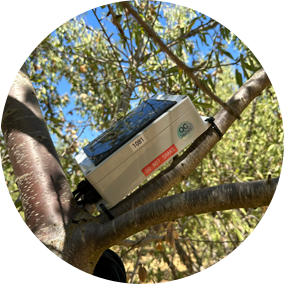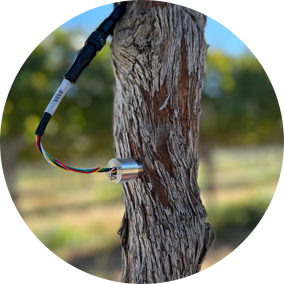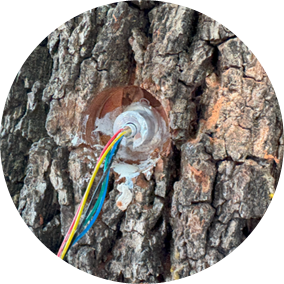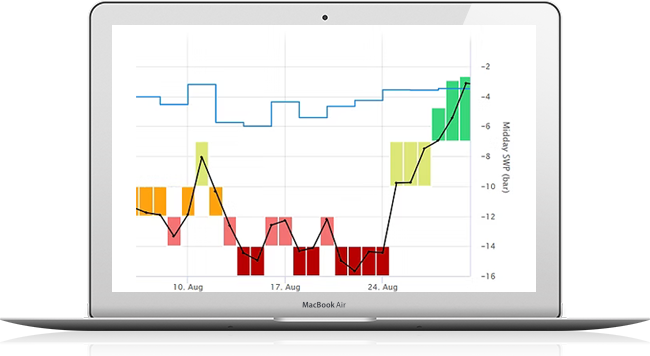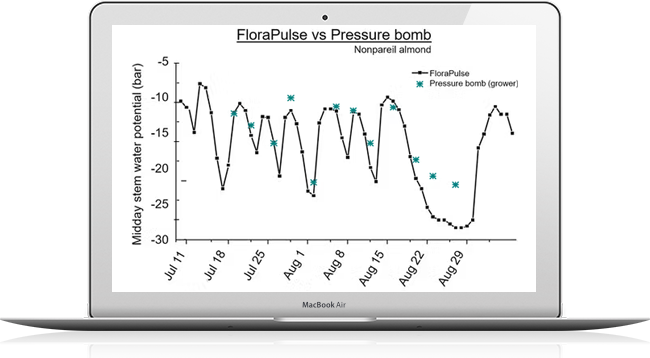About
FloraPulse
Retire the pressure chamber, know exactly when to irrigate, increase crop yield and quality.
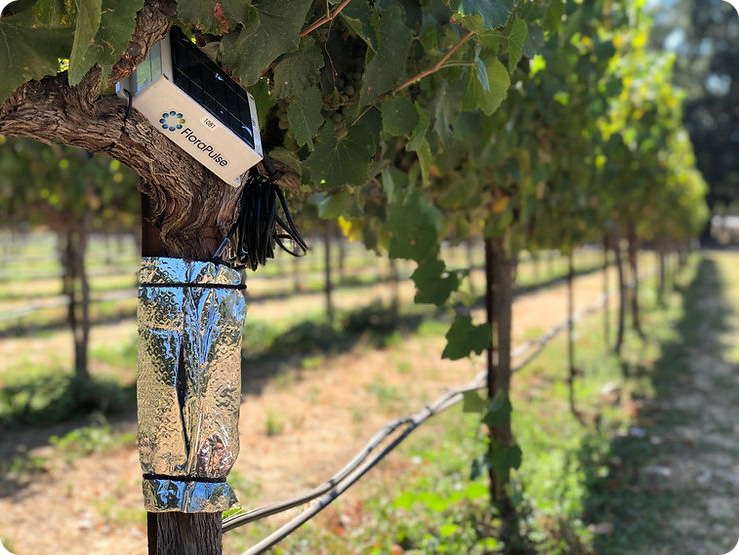
FloraPulse began in the orchards and vineyards of growers.
Since the 1970’s, Alan Lakso, professor of Horticulture at Cornell, had been dragging around the heavy, manual pressure chamber to measure and manage water stress in apple trees and grapevines. Alan was documenting the levels of water stress and their effect on fruit growth and quality. Back then, winegrape growers understood that water stress was important to wine quality, but only had the pressure chamber to measure it.
Why FloraPulse?
Understanding the Causes and Effects of Chlorosis
Chlorosis California presents a significant challenge for the state’s agricultural sector, particularly its lush vineyards and expansive orchards. But what exactly leads to Chlorosis California? This condition stems mainly from nutrient deficiencies, most commonly linked to a lack of iron in the soil. When soil pH levels become too high, the availability of iron diminishes, leading the leaves to turn a pale yellow while the veins remain green. This phenomenon isn’t merely cosmetic. Affected plants exhibit stunted growth and reduced fruit production.
Interestingly, this problem is often exacerbated by over-irrigation. Growers keen to ensure their crops receive ample water sometimes unintentionally flush essential nutrients away, worsening the symptoms of chlorosis. As a professional with over two decades of experience in this realm, I’ve witnessed firsthand the damage Chlorosis California can inflict on local agriculture.
The Hidden Dangers of Chlorosis in California’s Agriculture
While Chlorosis California is typically viewed as a nutrient-related issue, its broader implications reveal a more intricate web of challenges. When plants undergo nutrient deficiencies, they become more susceptible to other diseases and pest infestations. This vulnerability often spirals into a cycle of continuous stress, hampering the plant’s growth and fruit yield.
I’ve collaborated with many growers who initially didn’t realize the domino effect chlorosis can set off. Once the health of their plants began declining, many were caught in a web of unnecessary treatments and interventions. Through FloraPulse’s insights, we remind farmers of the importance of adopting a holistic approach to plant health, emphasizing microchip tensiometers to monitor water stress accurately.
Additionally, the financial implications cannot be ignored. With reduced yields and poorer fruit quality, farmers face potential economic setbacks, echoing the findings of studies highlighting the economic losses associated with this condition.
Steps to Combat Chlorosis California
- Soil Testing: Conduct comprehensive soil tests to gauge pH and nutrient levels. Identifying deficiencies early can make a world of difference.
- Nutrient-enriched Fertilizers: Implement the right type of fertilizer to restore the necessary nutrients. Chelated iron supplements are popular choices.
- Water Management: Employ tools like FloraPulse’s irrigation sensor to ensure optimal water levels. Avoiding over-irrigation is crucial in preventing nutrient washout.
- Regular Monitoring: Consistently monitor the plants for early signs of stress or nutrient deficiency, ensuring timely intervention.
- Expert Consultation: Engage with agricultural experts to gain insights tailored to specific crops and conditions.
What Qualifies as a Chlorosis California Emergency?
A Chlorosis California emergency arises when the symptoms threaten the yield and economic health of the crops. This can occur rapidly in conditions of sudden nutrient depletion or significant environmental changes.
In many instances, growers are caught off guard by the rapid yellowing of leaves, often misattributing the cause. With FloraPulse, I’ve engaged in numerous scenarios where quick adaptation and intervention were necessary to avert more severe damage. In emergencies, immediate soil amendment, nutrient supplementation, and precise irrigation adjustments can make a crucial difference.
For example, during a heatwave in the Central Valley, our FloraPulse system provided vital real-time data, enabling growers to respond swiftly and effectively.
Future Perspectives on Combatting Chlorosis in California
Looking forward, the battle against Chlorosis California is primed for innovation. As climatic conditions evolve and the agricultural sector faces new challenges, the symbiosis between technology and traditional farming practices becomes even more critical.
One promising avenue is the expansion of integrated precision farming solutions, leveraging data analytics to provide tailored solutions for individual plots. At FloraPulse, we’re committed to advancing this frontier, combining our time-tested sensors with cutting-edge analytics to provide growers with actionable insights.
Additionally, collaborative research efforts, funded by NSF and USDA, continually push the boundaries of what’s possible in combating chlorosis and similar issues. Engaging growers, technologists, and researchers in this dialogue promises a fruitful path forward.
My Journey with FloraPulse and Chlorosis California
Reflecting on my two-decade journey with FloraPulse, I’ve been privileged to witness the agricultural evolution in California. The scourge of Chlorosis California has always been a looming threat, yet it’s taught us resilience and adaptability. Through FloraPulse’s innovations, we’ve equipped growers with the tools they need to combat challenges effectively.
One of the most rewarding aspects has been the feedback from those who have applied our technology on the ground. Listening to narratives of improved yields and healthier crops validates our mission and fuels our passion. In essence, the battle against Chlorosis California isn’t just about combating a plant ailment; it’s about ensuring sustainability and prosperity for the agricultural heart of our state.
- Emphasizing the importance of continuous learning and adaptation
- Fostering a community of like-minded individuals committed to agricultural excellence
- Advocating for sustainable practices that prioritize plant and environmental health
What are the primary causes and effects of Chlorosis as observed in California’s agriculture?
Chlorosis in California’s agricultural landscapes, especially in vineyards and orchards, often stems from nutrient deficiencies, primarily a lack of iron due to high soil pH levels. This condition appears as yellowing of leaves while veins remain green, leading to stunted growth and reduced fruit yield. Over-irrigation can exacerbate the problem by washing away essential nutrients. I recall a vineyard owner who was diligent with irrigation yet faced declining plant health, highlighting the need for targeted soil tests and balanced fertilization strategies.
How can the hidden dangers of Chlorosis affect the overall health of crops and local economies in California?
The implications of Chlorosis extend beyond mere nutrient deficiency. Affected plants become susceptible to diseases and pests, which can lead to a cycle of stress and diminished productivity. Financially, lower yields and poor fruit quality can result in substantial economic setbacks for farmers. I’ve seen growers initially underestimate these risks, but utilizing tools like FloraPulse’s microchip tensiometers can provide real-time insights to mitigate such cascading effects.
What steps can growers take to combat Chlorosis and prevent its occurrence?
Tackling Chlorosis involves a combination of strategies: conducting soil tests to identify nutrient gaps, applying chelated iron fertilizers, and managing water use to avoid nutrient washout. Tools like FloraPulse’s sensors help maintain optimal irrigation levels. Regular monitoring and consulting agricultural experts add another layer of protection. A practical example is when a grower used FloraPulse’s recommendations and saw a noticeable improvement in plant vigor within a season.
What qualifies as a Chlorosis emergency, and how should farmers react?
An emergency situation emerges when rapid nutrient loss or environmental changes threaten crop yields. Quick diagnosis and action are crucial. With FloraPulse, we’ve helped farmers adjust irrigation during unexpected heatwaves by providing real-time data. I’m reminded of an instance in the Central Valley where swift interventions saved a grower from a potential disaster. It’s essential for farmers to have a contingency plan and react promptly using accurate data to guide their decisions.
What future advancements could help in the battle against Chlorosis in California?
The future of combating Chlorosis lies in integrating precision farming technologies. Data analytics can offer plot-specific solutions, enhancing traditional farming methods. At FloraPulse, we’re pioneering the use of advanced sensors and analytics to provide growers with actionable insights. Collaborative research efforts continue to push boundaries, and engaging in this evolving dialogue is crucial for thriving agriculture. Imagine a vineyard using predictive analytics to anticipate nutrient needs–this is the frontier we’re heading towards.
How has your experience with FloraPulse shaped your understanding of managing Chlorosis?
My journey with FloraPulse over two decades has reinforced the importance of technological integration in agriculture. Working directly with growers and seeing technology transform their practices has been rewarding. We’ve seen healthier crops and improved yields by equipping farmers with precise data. It’s not just about overcoming Chlorosis; it’s about sustainable agriculture. As one grower told me, using our technology has made them feel more in control of their farm’s future.
How It Works
How It Works
The FloraPulse system is a microchip tensiometer (microtensiometer) that is embedded into the tree woody tissue and directly measures the water status, known as water potential. Because the measurement is taken directly inside the water-carrying tissue, readings are very accurate and reliable. You receive daily midday stem water potential readings, along with science-backed irrigation recommendations.
Weekly Reports
Receive weekly reports on your crop’s water-stress history, color-coded by stress level. Use clear, detailed data to adjust your irrigation and get that perfect vintage, that perfect yield. Every year.
Scientific Validation
The sensor data has been validated against the Scholander chamber with good correlation in prune, almond, winegrape (and others).
Technology Backers

Our technology has been funded by the NSF and USDA, and was originally developed at Cornell University.
What is FloraPulse?
The most accurate way to irrigate.
Customer Testimonials
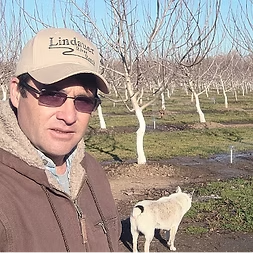

“We were extremely happy with the FloraPulse system we tested in our prune orchard this year. We found that the FloraPulse readings correlated very well with our pressure bomb readings…
Michael Vasey
Lindauer River Ranch
Red Bluff, California
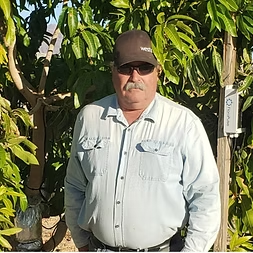

“I am very happy with the FloraPulse unit. I grow a rare mango crop, in a desert environment with extremely high summer temperatures, in alluvium soil that has very limited…
Rod Chamberlain
Wong Farms
Mecca, California


